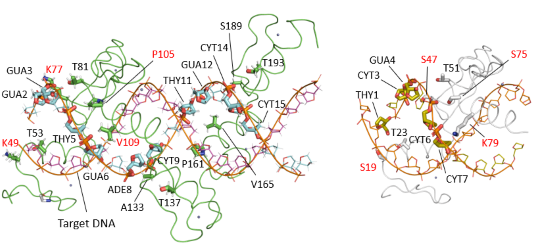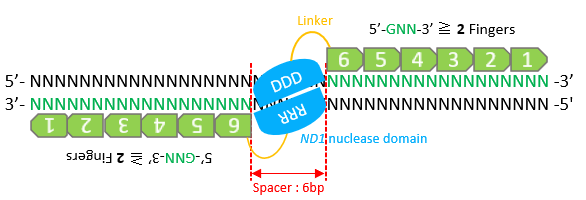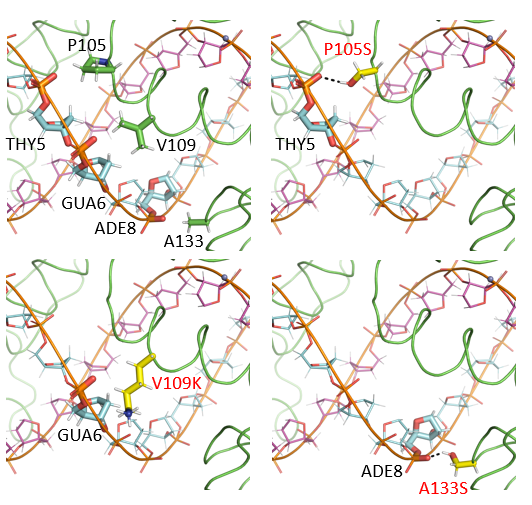Genome editing is making inroads into biomedical research and medicine. By employing biomolecule modeling tools, a Japanese research team is accelerating the pace and cutting the cost of zinc finger nuclease (ZFN) technology, a primary gene editing tool.
Zinc finger nucleases (ZFNs) have great potential for translational research and clinical use. Scientists succeeded in the efficient construction of functional ZFNs and the improvement of their genome editing efficiency using biomolecule modeling tools. (Shota Katayama/Hiroshima University)
In a recently published study, researchers from Hiroshima University and the Japanese National Institute of Advanced Industrial Science and Technology demonstrated how machine learning-driven modular assembly systems can improve gene editing.
The study was published on April 10 in the journal Advanced Science.
“Genome editing is a promising tool for the treatment of genetic disorders in a number of different fields,” said Shota Katayama, associate professor in the Genome Editing Innovation Center at Hiroshima University. “By improving the efficiency gene editing technologies, we can achieve greater precision in modifications to the genetic information in living cells.”
Alongside CRISPR/Cas9 and TALEN, zinc finger nuclease is an important tool in the field of genome editing. Engineered to break certain bonds within the polynucleotide chain of a DNA molecule, these chimeric proteins are made up of two domains fused together: DNA-binding and DNA-cleavage domains. The zinc finger (ZF) protein binding domain recognizes the targeted DNA sequence within the complete genome, while the cleavage domain involves a special DNA-cutting enzymes called ND1 endonucleases.

Model of interaction between ZF and DNA (Shota Katayama/Hiroshima University)
ZFN present a few advantages over CRISPR/Cas9 and TALEN: first, unlike for CRISPR-Cas9, the patents for ZFNs have already expired, precluding high patent royalties for industrial applications. Secondly, ZFN are smaller, allowing for ZFN-encoding DNA to be easily packaged into a viral vector with limited cargo space for in vivo and clinical applications.
To cut DNA, two ZFNs must be bonded. Therefore, they must be designed in pairs to be functional at any new site. However, constructing functional ZFNs and improving their genome editing efficiency has proved challenging.
“We’ve made huge strides in methods for deriving zinc-finger sets for new genomic targets, but there is still room to improve our approaches to design and selection,” Katayama said.
Model of interaction between mutations showing increased activity and DNA (Shota Katayama/Hiroshima University)
Selection-based methods can be used to construct assembled ZF proteins, but these methods are labor intensive and time-consuming. An alternative approach for constructing assembled ZF proteins is the assembly of ZF modules using standard molecular biology techniques. This method provides researchers with a much easier method to construct assembled ZF proteins.
However, modularly assembled ZFNs have a small number of functional ZFN pairs with a 94 percent failure rate for the ZFN pairs tested.
In their study, the researchers from Hiroshima University and the Japanese National Institute of Advanced Industrial Science and Technology aimed to create a more efficient, easily constructable zinc finger nuclease for gene editing using publicly available resources in a modular assembly system.
An important consideration in the design of ZFNs is the number of zinc fingers that are required for efficient and specific cleavage. The team hypothesized that the modular assembly of the ZF modules would be useful for constructing ZFNs with five or six fingers.
In their publication, the research team presented a method to increase the efficiency of construction of functional ZFNs and the improvement of their genome editing efficiency using three biomolecule modeling tools: AlphaFold, Coot and Rosetta.
Of the ten ZFNs tested, the researchers obtained two functional pairs. Furthermore, the engineering of ZFNs using AlphaFold, Coot and Rosetta increased the efficiency of genome editing by 5%, demonstrating the effectiveness of engineering ZFNs based on structural modeling.
The research is supported by the Center of Innovation (COI) Program.
Other contributors include Masahiro Watanabe and Yoshio Kato from the National Institute of Advanced Industrial Science and Technology, and Wataru Nomura and Takashi Yamamoto from Hiroshima University.
About the study
Journal: Advanced Science
Title: Engineering of Zinc Finger Nucleases Through Structural Modeling Improves Genome Editing Efficiency in Cells
Author: Shota Katayama, Masahiro Watanabe, Yoshio Kato, Wataru Nomura & Takashi Yamamoto
DOI: 10.1002/advs.202310255
Journal Citation Indicator (JCI) Quartile: Q1
Related faculty members
Media Contact
Inquiries on the study
Shota Katayama
Associate Professor (Special Appointment), Hiroshima University Genome Editing Innovation Center
E-mail: shota-katayama * hiroshima-u.ac.jp
(Note: Please replace * with @)
Inquiries on the story
Hiroshima University Public Relations Office
E-mail: koho * office.hiroshima-u.ac.jp
(Note: Please replace * with @)

 Home
Home

















